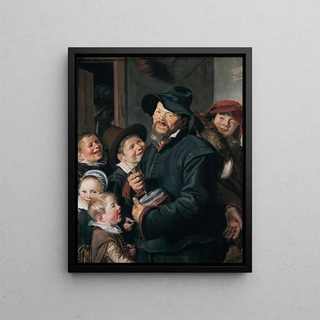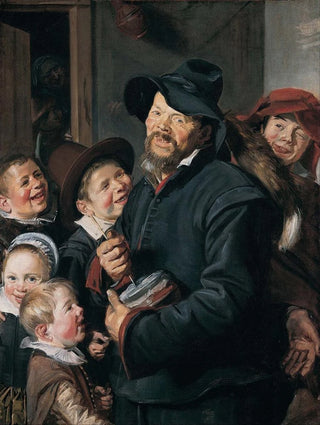Art print | The Player of Rommel-Pot - Frans Hals


View from behind

Frame (optional)
In the fascinating world of 17th-century Dutch painting, "The Rommel-Pot Player" by Frans Hals stands out for its dynamism and liveliness. This artwork, which captures a moment of conviviality and play, evokes a snapshot of daily life at a time when social interactions played a prominent role. The piece, both playful and full of life, transports us to a scene where the joy and innocence of the young protagonists illuminate the canvas. Frans Hals, master of light and movement, succeeds in immortalizing an atmosphere of simple happiness, making this art print timeless and universal.
Style and uniqueness of the work
The style of Frans Hals is characterized by a free and expressive painting technique, which is particularly evident in "The Rommel-Pot Player". Vigorous brushstrokes and a vibrant color palette infuse a palpable energy into the scene. The faces of the young players, imbued with contagious liveliness, seem almost to emerge from the canvas, while the blurred background enhances the sense of movement. This art print also stands out for its asymmetrical composition, which draws the eye and creates a captivating visual dynamic. Hals manages to capture the precise moment when the game becomes a symbol of camaraderie, while demonstrating his skill in depicting human emotions with disarming simplicity.
The artist and his influence
Frans Hals, born in Antwerp in 1582, played a crucial role in the development of Dutch painting. His innovative approach, which emphasizes the rendering of expressions and emotions, inspired many artists of his time and beyond. By moving away from rigid academic conventions, Hals paved the way for a freer form of art, where spontaneity and authenticity took precedence over technical perfection. "The Rommel-Pot Player" perfectly illustrates this artistic vision, highlighting the joy of living and human interaction. His influence is reflected in the works of many painters, from Impressionists to contemporary artists, who continue to explore themes of conviviality and daily life.
An exceptional wall decoration signed

Matte finish

View from behind

Frame (optional)
In the fascinating world of 17th-century Dutch painting, "The Rommel-Pot Player" by Frans Hals stands out for its dynamism and liveliness. This artwork, which captures a moment of conviviality and play, evokes a snapshot of daily life at a time when social interactions played a prominent role. The piece, both playful and full of life, transports us to a scene where the joy and innocence of the young protagonists illuminate the canvas. Frans Hals, master of light and movement, succeeds in immortalizing an atmosphere of simple happiness, making this art print timeless and universal.
Style and uniqueness of the work
The style of Frans Hals is characterized by a free and expressive painting technique, which is particularly evident in "The Rommel-Pot Player". Vigorous brushstrokes and a vibrant color palette infuse a palpable energy into the scene. The faces of the young players, imbued with contagious liveliness, seem almost to emerge from the canvas, while the blurred background enhances the sense of movement. This art print also stands out for its asymmetrical composition, which draws the eye and creates a captivating visual dynamic. Hals manages to capture the precise moment when the game becomes a symbol of camaraderie, while demonstrating his skill in depicting human emotions with disarming simplicity.
The artist and his influence
Frans Hals, born in Antwerp in 1582, played a crucial role in the development of Dutch painting. His innovative approach, which emphasizes the rendering of expressions and emotions, inspired many artists of his time and beyond. By moving away from rigid academic conventions, Hals paved the way for a freer form of art, where spontaneity and authenticity took precedence over technical perfection. "The Rommel-Pot Player" perfectly illustrates this artistic vision, highlighting the joy of living and human interaction. His influence is reflected in the works of many painters, from Impressionists to contemporary artists, who continue to explore themes of conviviality and daily life.
An exceptional wall decoration signed






